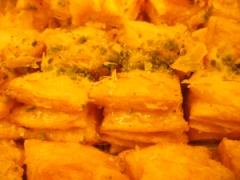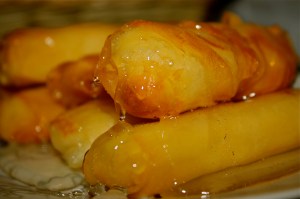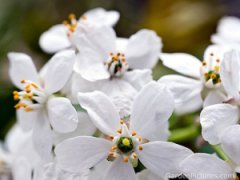Amouage‘s new Renaissance Collection marks the beginning of a new era for the Omani brand; its most popular release, Crimson Rocks, is the subject of today’s review. One of four fragrances, Crimson Rocks eschews Amouage’s old system of having twin Man/Woman fragrances on the same theme. Instead, there are four new unisex fragrances, each with a different focus. Crimson Rock’s focus is a cinnamon-spiced, honeyed, slightly gourmand and very woody desert rose which eventually becomes a honeyed, spicy, rose-tinged woody amber.
Tag Archives: Amouage perfume review
Amouage Epic (Man)
The Silk Road’s legendary spice route from China to Arabia winds its way across the face of Epic for Men from Amouage. It is a very unisex fragrance that is an enjoyable swirl of spices, woods, incense, golden sweetness, and creaminess, but it is neither the fragrance that I expected nor very “epic” in nature. Not now….
Epic Man (hereinafter just “Epic”) is an eau de parfum that was created by Randa Hammami and released in 2009. The inspiration was two-fold: the legendary Silk Road and Puccini’s Turandot opera which is set in China but based on a tale involving a Persian princess and a deadly riddle. First in Fragrance has the company’s complete press description:
The theme of this latest Amouage fragrance is the legendary aria from Puccini´s unfinished opera, Turandot. The legend says that one day the composer Puccini completed the opera and then buried the completed work somewhere in the sands along the Silk Road. The last act of the opera, it is said, was an incomparable aria, which could not possibly be sung by a human voice…
The legendary city of Ubar in Oman is the starting point for a journey in search of this missing aria, which leads us along the Silk Road through the Orient and over the highest mountains in the world – to China. The way of the ancient caravans, that carried silk and other treasures over many hundreds of miles, where tea, gold, pearls and jade from China where exchanged for precious silver frankincense from the Oman – a legendary land where the valuable raw materials can be found that were used in the composition of this new Amouage fragrance.
Amouage Epic (Woman): Turandot at The Forbidden City
The legends of the ancient Silk Road that wove its way from the Middle East to China, Puccini’s Turandot princess, the grandeur of the Forbidden City and the Dragon Empress’ Summer Palace, a veil of frankincense, and a dry desert wind that swirls spices around the lushness of a velvet red rose — those are a few of the things at the heart of Epic for Women from Amouage. Oh, and pickles as well. Yes, I said pickles….
Epic Woman (hereinafter just “Epic”) is an eau de parfum that was released in 2009. It was created by Daniel Maurel (who also did Lyric Woman for Amouage) under the direction of Christopher Chong. The inspiration was Puccini’s Turandot opera which is set in China, but which was based on an ancient tale involving a Persian princess and a deadly riddle. China had once banned the opera, but welcomed it with open arms in 1998 when it permitted a massive $15 million film production of the opera to be set in the 500-year old Forbidden City under the direction of the showman, Zhang Yimou (who later did the Beijing Olympics), with the opera conducted by the famed Zubin Mehta. I own the DVD, and the production is one of the most spectacular, extravagant, unbelievably opulent things you can imagine, so I sat up a little when I heard about the Turandot connection to Amouage’s Epic.
Amouage Al Mas & Asrar Attars
Red, yellow, orange, and gold. An explosion of vibrantly bright colours that are infused with tendrils of smoke, and which soon turns into the browns of smoky oud. The beauty that is saffron showcased in two ways: sweet and dry, gourmand and woody. And the richness of an ancient attar as a common thread between the two. They are Al Mas and Asrar, “The Diamond” and “The Secret,” from the royal perfume house, Amouage.
I was lucky enough to have the opportunity to try these two, lesser known Amouage attars, thanks to the kindness of a reader of the blog, “Dubaiscents,” who generously sent me a sample of each. I was surprised by how the two attars seemed to be mirror opposites of each other, showing two differing approaches to the traditional Middle Eastern combination of saffron and oud. (Attars are concentrated perfume oils, and if you’d like to know more about the millenium-old process by which they are created and how they differ from essential oils, you can read the brief explanation in my review of the glorious Tribute attar.) Both Al Mas and Asrar are simple attars that are well-done, and which I thoroughly enjoyed testing, but neither one really sings loudly to me.
AL MAS:
On Valentine’s Day, 2010, Amouage released Al Mas, which apparently means “diamond” in Arabic. It opens as a delicious gourmand attar centered on saffron and rose, atop a subtle base of woods. Unlike some modern attars which use paraffin to compensate for the lack of real sandalwood oil as a base, Al Mas includes some of that precious oil, in addition to oud. The notes, according to Surrender to Chance, include:
roses, oriental spices, saffron, amber, musk, sandalwood oil, oudh wood oil and cedarwood.
The first few seconds of Al Mas on my skin are a little similar to the glorious Tribute attar, only without the tarry birch and its loads of dark smoke. The impression of a gourmand version of Tribute lasts but for a few moments, however, as the fragrance quickly turns into every delicious Middle Eastern saffron dessert imaginable. There are gallons and gallons of sweet, syrupy saffron and rose, followed by amber, musk, and the most delicate hints of oud.
The saffron dominates, turning everything in its path into visions of fiery red, gold, orange, and bright custard yellow. The syrupy, sweet rose follows suit, combining with the saffron to add to the overall impression of a rich Middle Eastern pastry or dessert. If you’ve ever had Persian Sholeh Zard or Zoolbia, Indian Phirni or Kheer, Lebanese Riz B Haleeb with saffron, or any variety of syrupy, saffron and/or rose-infused pastry from Egypt to Turkey, you’ll have some idea of both the visuals and the feel of Al Mas. Yet, the attar isn’t completely and wholly a foodie’s saffron fantasy. There are delicate whiffs of a very nutty, warm, mellow sandalwood and sweetened oud which flicker at the edges, along with the merest hints of a peppery cedary and musk. A subtle smokiness curls its tendrils around the far edges, sometimes feeling more like the suggestion of frankincense than anything sharply concrete.
Five minutes in, Al Mas turns profoundly nutty and honeyed. I almost expect to see pistachios and nuts sprinkled on top of the saffron rose. A powerful layer of treacly, gooey, thick honey quickly infuses the duo, overwhelming the hints of smoky incense and adding to the impression of Middle Eastern desserts. Whatever mild, momentary resemblance there may have been to the Tribute attar in the opening minute is long obliterated under the tidal wave of sweetness. The sweetness in Al Mas impacts the rose, turning it deeper, sweeter, and quite fruity in its syrupy heart. The fruitedness really makes me wonder if there is a very dark, purple patchouli at play in Al Mas as well. I would swear that there is the subtlest, tiniest hint of raspberries underlying the scent, and it’s hard to shake off for much of the first hour.
Around the 90-minute mark, Al Mas shifts and changes. It suddenly turns much drier, and starts to hover closer to the skin. The smoke has increased, as has the oud, countering the sweetness in the fragrance with an equal amount of smoky woodiness. With every passing hour, the syrupy, gourmand elements in Al Mas weaken, and the oud-frankincense combination grows in strength.
The fragrance turns into a skin scent about 3.5 hours in, wafting a sheer, delicate gauzy veil of oud smoke with nutty, sweet saffron and a touch of rose. Al Mas feels quite thin in comparison to that extremely heavy, rich, almost unctuous start. I actually applied far more of Al Mas than I did of Tribute, but the latter was a profoundly richer, deeper, stronger, and more nuanced scent with far less. Al Mas, in contrast, is much simpler in nature, and primarily limited to a smoky oud-with-saffron combination despite using almost double the amount (4 small drops). I’m a little surprised by how quickly the rose element faded away on my skin; by the start of the fourth hour, it’s largely disappeared. Soon, Al Mas is nothing more than wispy oud with saffron and, 7.5 hours into its development, it dies completely.
Al Mas isn’t listed on the Fragrantica site, and I can’t find any blog reviews for it except for one. Over at The Perfume Posse, a reviewer called Musette writes about the attar but I find myself somewhat confused by her assessment. She talks about the fragrance’s lightheartedness with geranium, clary sage, and lily of the valley! She also says: “The notes (courtesy Surrender to Chance) are counterintuitive to what I deemed ‘attar’ : orange blossom, lemon and rosemary; middle notes of lily of the valley, geranium and clary sage; and base notes of sandalwood, oak moss and musk.” None of those notes are what are commonly attributed to Al Mas or, even, what is currently listed on Surrender to Chance’s entry for the perfume oil. There must be some sort of mix-up in attars, and in the sample she obtained. Either that, or my nose is completely wonky because I swear I don’t smell a whiff of anything remotely “light-hearted,” green, and white in Al Mas. On me, the attar is primarily saffron and rose, and then, later, smoky oud and saffron.
ASRAR:
When Amouage had its 25th Anniversary celebrations in 2007, they released a special attar called Asrar (also, sometimes written as “Asrer“). According to Fragrantica, Asrar means “secrets” in Arabic, and the tale associated with the attar is as follows:
Interwoven with golden hints of, the plot of Asrar, whose name in Arabic means “Secrets”, is decorated with notes, as if by magic, they appear under the nose an oriental garden nestled between Dream and Reality. […] A touch of saffron, a handful of spices, four drops of amber, musk, and then a puff of a distillate of Oudh, the bark of an infusion of exotic wood and sandalwood.
The full notes in Asrar, as compiled from Fragrantica, Surrender to Chance, and the ASF-Dubaishop perfume retailer, includes:
oud, oudh distillate, rose, amber, frankincense, musk, saffron, orange blossom, sandalwood oil, and moss.
 Asrar opens on my skin with a powerful blast of fiery saffron that is so rich, it feels almost buttered. It’s so buttered and hot, in fact, so hot and buttered, that I almost expect a plate of Basmati rice to ensue. Moments later, other elements appear. There are subtle whiffs of burnt orange, smoky orange, and sweet, buttered orange with saffron, but they are very brief. Equally light and muted are the flickers of rose and frankincense which lurk below. The main, primary focus, however, is that strong blast of saffron. It differs from the note in Al Mas where it is wholly gourmand in feel, because, here, the saffron is a little bit smoky, a touch woody, and infused with a burnt element.
Asrar opens on my skin with a powerful blast of fiery saffron that is so rich, it feels almost buttered. It’s so buttered and hot, in fact, so hot and buttered, that I almost expect a plate of Basmati rice to ensue. Moments later, other elements appear. There are subtle whiffs of burnt orange, smoky orange, and sweet, buttered orange with saffron, but they are very brief. Equally light and muted are the flickers of rose and frankincense which lurk below. The main, primary focus, however, is that strong blast of saffron. It differs from the note in Al Mas where it is wholly gourmand in feel, because, here, the saffron is a little bit smoky, a touch woody, and infused with a burnt element.
There is also something oddly chilly about the bouquet, a flicker of something almost mentholated that perplexes me. It’s not like eucalyptus or like medicine, but just barely floral in suggestion. My guess is that the indoles in the orange blossoms have been concentrated to such an extent that they’ve taken on a vaguely icy feel. It’s hard to explain, but there is a surprising, subtle coolness to Asrar that sharply counters the hot butteriness of the saffron. Yet, on my skin, it never translates at any point to orange blossoms — and I tested Asrar twice. The attar also doesn’t feel even remotely orange-y, despite the initial, disappearing whiffs in the first minute, so my skin obviously muted the note for the most part.
It is another flower, instead, which dominates the first hour of Asrar on my skin: the rose. It makes its debut about five minutes in, and it’s another syrupy, sweet, slightly jammy rose that feels a little bit fruited in its richness. Like everything else, it is flecked by the fiery, heavy saffron, and the two notes dance a solitary tango for most of the first hour.
Thirty minutes in, the chilly nuance vanishes, and is replaced on the sidelines by a hint of smoke that has a slightly burnt undertone. At times, the smokiness smells like burnt woods, but, at other times, it resembles the pungent, acrid sharpness that you’d get from blackened caramel. At the 90-minute mark, the note coalesces and takes shape as noticeable, distinct oud. It adds a more concrete woodiness to the scent, but it retains its slightly smoky undercurrents as well, perhaps from what Amouage terms of “oudh distillate.”
The agarwood and its smoke slowly become more and more prominent, taking over the buttery heaviness of the saffron and cutting it with dryness. Around 2.75 hours into Asrar’s development, the fragrance is primarily smoky oud with saffron. The rose has retreated a little to the periphery, and there is the start of a slightly medicinal edge to the wood notes. By the end of the fourth hour and the start of the fifth, Asrar is primarily an oud scent that is simultaneously dry, a little smoky, and a little medicinal. There are quiet undercurrents of saffron underlying it, and the whole thing sits right on the skin. Asrar remains that way until its very end when it’s nothing more than dry, somewhat medicinal oud with smoke. All in all, the attar lasted just short of 8 hours on my skin, and had generally soft sillage.
I couldn’t find any blog reviews for Asrar, but there are short assessments at some of the perfume groups. On Fragrantica, one person found the attar to be very similar to Tribute, while another thought Asrar was a herbal, floral garden ruled by saffron but with an undertone of “freshly applied rubbing alcohol,” no doubt from the oud. The third found Asrar to be simultaneously “very, very sweet,” and discordantly harsh. On Basenotes, there are also three reviews of Asrar, all of which give the fragrance 5-stars. For the most part, the commentators seem to detect much more orange blossom than I did. For example, one person wrote:
The combination of orange blossom and rose smells very familiar and friendly, but the oud and the saffron give a medicinal edge to it. It’s also very spicy, it almost feels “hot” in the nose! Absolutely unisex and in my humble opinion better than Homage or Tribute. The combination of warm top-notes and a mysterious, almost fierce base is totally stunning!
The second commentator also noted the floral elements in Asrar, adding: “It shares a little something with APOM by MFK, but with several additional notes. Everything anyone could want in a feminine attar.” The last found Asrar to be far better suited for her than Amouage’s Ubar, Lyric, or Gold perfumes, and as warmly comforting as a bath:
a rare scent, sweet and yet a little bit pungent through the massively overpowering effect of the saffron. Asrar is mainly a *saffron* scent. Thus, it has a slight reminiscence of a Tibetan temple, of Iranian saffrani chai (saffron tea) of the brand “Zanbagh”. But, then, it is infinitely sweeter than a temple, it is sweet and warm like a warm warm bath, like a lovely embrace… […] After a while, a new smell develops on my skin, like a slight reminiscence of Indian paan, the stuff they eat after dinner there, which lifts the scent up through it’s zest from the mere warmy nicey lovely bath idea[.]
The fact that all six Fragrantica and Basenotes commentators had such widely divergent experiences is interesting to me. Obviously, skin chemistry plays a key role, but I think it’s also a question of the personal experiences through which one’s nose filters the powerful saffron note. For some, it will translate as too sweet, for others, it will be a comforting scent with some foodie associations. Ultimately, how you feel about Asrar may depend on the extent to which the florals and the oud (with its medicinal undertones) come out to counter the warm, fiery, buttery richness of the saffron.
ALL IN ALL:
I enjoyed parts of Al Mas. I thought the opening was delicious, perhaps because I love saffron enough to counter my usual issues with foodie or dessert fragrances. The rose and the subtle, brief hints of sandalwood were very nice, too, but at the end of the day, the fragrance isn’t really me. On the plus side, however, Al Mas is significantly and substantially cheaper than Amouage’s better known attars like Tribute and Homage. You can find the smallest size starting at $151, which is a few hundred dollars off Tribute’s opening price of $370. If you love saffron, gourmand fragrances, or ouds that eventually turn dry and smoky, Al Mas is definitely worth checking out.
As for Asrar, I didn’t fancy it quite as much. On my skin, the saffron felt like a woodier, drier, less gourmand, but significantly more buttery-hot version of the note in Al Mas. I wish I had experienced the orange blossoms, but instead, there was the oddly medicinal edge to the fragrance that isn’t my favorite aspect of agarwood. As a whole, I don’t think my skin chemistry highlighted the prettier aspects or nuances of Asrar, since it seems quite lovely on others.
As a whole, both perfumes are well done, though quite simple and uncomplicated in nature. They’re also on the more affordable end of the scale for an Amouage attar, relatively speaking. Though they share some overlap in notes, Al Mas and Asrar feel very much like mirror opposite interpretations on saffron and oud, with one starting on a gourmand note before turning woody and smoke, while the other is more fiery and buttered before engaging in a similar transformation. The oud accord is different in each, as is the floral undertone, so both Al Mas and Asrar may be worth a sniff for different reasons.















